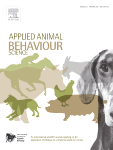Document type: Scientific article published in Frontiers in Veterinary Science
Authors: Katharina Schodl, Lisa Wiesauer, Christoph Winckler, Christine Leeb
Preview: The aim of this study was to investigate the impact of reduced stocking density in combination with provision of additional enrichment material on pig welfare on-farm. On three growing-finishing farms in Austria, in total 974, 413, and 70 pigs were kept at 1 m2/pig and straw or hay in a rack as additional enrichment material (improved pens, IP; n = 6-38 pens per farm) or in pens complying with the minimum legal requirements of 0.7 m2/pig (control pens, CP; n = 6-37 pens per farm). Behavior as well as skin, tail and ear lesions and pig soiling were assessed at the beginning and in the middle of the fattening period, while performance data were recorded at the end of the fattening period. Data analysis was performed for each farm separately using generalized linear and linear mixed models or Mann-Whitney U-Test. Pigs in IP less frequently manipulated pen mates' ears (Farm 1: Ptreatment∗assessment = 0.002; Farm 2: P = 0.002) and body (Farm 1: P = 0.021; Farm 2: P = 0.015) than in CP. Prevalence of skin, tail and ear lesions and soiled pigs did not differ between treatments. In only one farm, average daily weight gain was higher in IP than in CP (Farm 1: P = 0.003). Our findings indicate that increased space allowance and provision of substrate can improve aspects of animal welfare within existing pig fattening systems, without requiring irreversible constructional modifications to the system.






